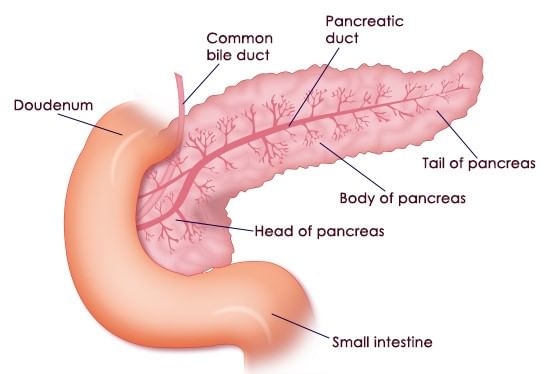Digestive Gland: Pancreas & Salivary Glands | Biology for Grade 11 PDF Download
What is Pancreas?
- The pancreas is an abdominal organ located behind the stomach and surrounded by the spleen, liver and small intestine. It is a vital part of the digestive system and is responsible for regulating blood sugar levels.
 Pancreas
Pancreas - The pancreas secretes digestive enzymes such as amylase, proteases and lipase into the duodenum. These enzymes help in digesting sugar, proteins and fat respectively. Islets of Langerhans are embedded in the pancreas that secretes hormones such as insulin and glucagon into the blood.Question for Digestive Gland: Pancreas & Salivary GlandsTry yourself:Which part of the pancreas produces and secrete insulin?View Solution
➢ Pancreas Location
- The pancreas is located in the abdomen. A part of it is placed between the stomach and the spine. The other part finds its place in the curve of the first section of the small intestine, known as the duodenum.
 Location of Pancreas
Location of Pancreas - The head of the pancreas is on the right side of the abdomen and is connected to the duodenum through the pancreatic duct. The tail of the pancreas extends to the left side of the body.
➢
Pancreatic Diseases
- Due to the inaccessibility of the pancreas, the evaluation of pancreatic diseases could be difficult.
- Disorders that affect the pancreas include precancerous conditions, pancreatitis, and pancreatic cancer. Each disorder exhibits different symptoms and needs different treatments.
(i) Pancreatitis
Pancreatitis is swelling when the pancreatic enzyme is secreted and begins to digest the organ itself. It could exist as painful attacks or a chronic condition that lasts for years.
(ii) Precursors to Pancreatic Cancer
The primary reason for pancreatic cancer is yet to be known, but there are risk factors that increase the danger of developing diseases. Some of the factors include smoking or hereditary cancer syndromes.
(iii) Pancreatic Cancer
Pancreatic adenocarcinoma is one of the most common forms of pancreatic cancer. It is an exocrine tumour that arises from the cells that line the pancreatic duct. A tumour of the endocrine gland accounts for less than 5% of all pancreatic tumours and is referred to as islet or neuroendocrine.
➢
Pancreas Function
The pancreas performs the following functions:
(i) Exocrine Function
The pancreas consists of exocrine glands that produce enzymes trypsin and chymotrypsin that are essential for digestion. These enzymes contain chymotrypsin and trypsin to digest proteins, amylase for the digestion of carbohydrates and lipase to break down fats. These pancreatic juices are liberated into the system of ducts and culminated in the pancreatic duct when the food enters the stomach.
(ii) Endocrine Function
The endocrine part of the pancreas comprises Islets of Langerhans that release insulin and glucagon directly into the bloodstream. They help in regulating the blood sugar levels of the body.
Salivary Glands
 Salivary Glands
Salivary Glands
In mammals, 4 pair of salivary glands are present. These are:
1. Infra-orbital Glands
- Gland is located just below the eye-orbit.
- The duct of these glands open in the upper-jaw near the 2nd molar teeth.
2. Parotid Glands (Largest Salivary Glands)
- These glands are located just below the external auditory canal. Their duct is called Parotid duct/Stenson's duct which open in the upper jaw i.e. the Buccal-vestibule.
- Whenever in human, these glands are infected by viruses this disease is called as Mumps. Due to this, the gland swells up.
3. Sub Maxillary or Submandibular Glands
- These are located at the junction of the upper and the lower jaw.
- Their duct is called Wharton's duct (largest salivary duct). These ducts open in the lower jaw just behind the Incisor teeth.
4. Sublingual Glands
- These are the smallest salivary glands. These glands are found in the lower jaw. Many ducts arise from these glands called as the Ducts of Rivinus or Bartholin's ducts. These ducts open in the bucco-pharyngeal cavity on the ventral side of the tongue.
- Maximum saliva is secreted by the Sub-lingual glands. (Smallest salivary duct) Salivary glands are Exocrine glands. The secretion of salivary glands is termed as the saliva.
Composition of saliva
- Water - 99.5 %
- Mucus, starch -digesting Ptyalin enzyme, lysozyme and thiocyanates and few ions like sodium, potassium, chloride, IgA antibody, urea and uric acid etc., are present.
- Ptyalin is secreted only by the parotid gland. Lysozyme and Thiocyanates mainly kill bacteria. They also check the growth of bacteria in bucco-pharyngeal cavity.
- Salivation is stimulated by cranial nerve VII & IX.
- In addition to it 5th pair of molar gland is found in Cat which is situated near to the upper molar teeth and also opens near upper molar teeth.
|
219 videos|306 docs|270 tests
|
FAQs on Digestive Gland: Pancreas & Salivary Glands - Biology for Grade 11
| 1. What is the function of the pancreas? |  |
| 2. How are salivary glands different from the pancreas? |  |
| 3. What is the composition of saliva? |  |
| 4. How does the pancreas contribute to the digestive process? |  |
| 5. How does the pancreas regulate blood sugar levels? |  |






















